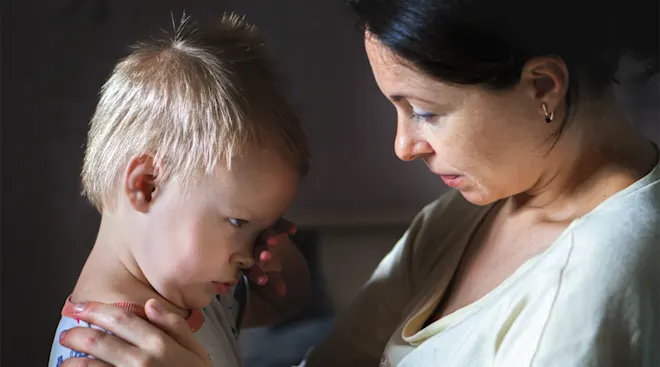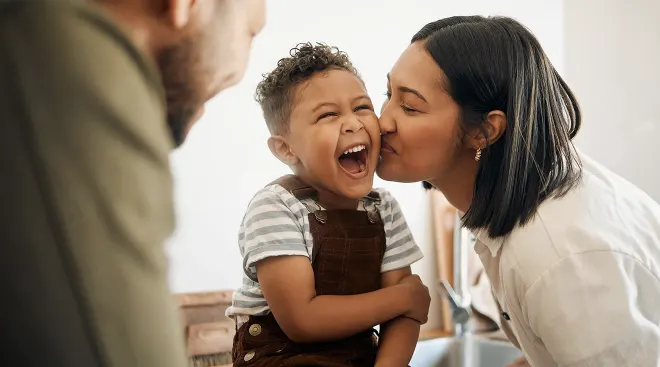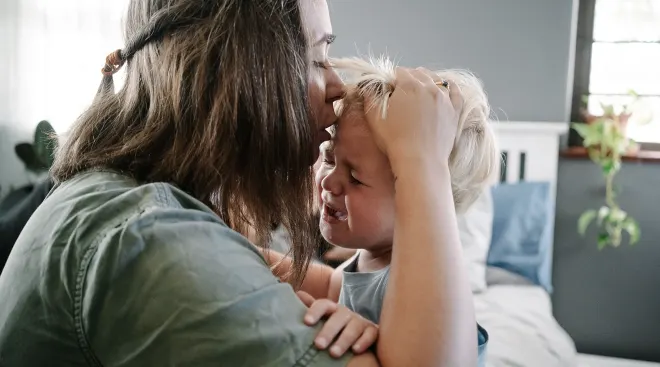What Is a Velcro Baby? and How to Cope With Clinginess
Most babies want to be held as often as possible, and we can’t blame them. If we were suddenly born into a big, bright, cold world, we’d want to be cuddled and carried around by our favorite people all the time too. But some babies take this to the extreme, wanting to be in Mom or Dad’s arms all the time—no exceptions, no valid excuses. We call these super-clingy infants “Velcro babies,” and if you’ve got one, you’re not alone.
“I most definitely had a Velcro baby,” says Stephanie O., mom of three in the San Francisco Bay Area. “I used to nurse on the toilet because she never wanted to be put down! Every major developmental milestone meant weeks of extra clinginess.”
Having an excessively needy baby can be exhausting, especially if “clingy” is their default setting rather than a temporary response to something happening in their little baby life, like an illness or teething. Although clinginess is totally normal—and actually a sign that baby loves you a lot!—it’s reasonable to want some personal space once in a while. Here’s why some babies are more clingy than others, what triggers clingy phases and how to cope when your Velcro baby won’t even let you pee alone.
A Velcro baby is one that’s pretty much always stuck to you. They want to be in your arms as much as possible and are rarely content to be put down. The term barnacle baby” may also resonate. Basically, your little one is like the little sea creature that clings to hard surfaces underwater. You’ve probably heard the expression “attached at the hip,” right? Well, Velcro babies take that expression to new heights. They’re basically another appendage on your body!
Babies who are extra clingy may also fall into the category of a “high need” baby. Although there isn’t a lot of science on high-needs babies, many child development experts believe some littles are simply more sensitive or intense than others.
A high-need or Velcro baby may be prone to extra fussiness, sleep less reliably than other babies or seem more sensitive to routine changes and new people. They may also be perfectly content while you’re holding them and then start crying the minute you try to put them in their car seat or crib, even if you’ve met all of their needs, like feeding and changing. Finally, Velcro babies often have a hard time settling down, needing a lot of swaying, shushing and soothing in order to sleep or feel calm.
Some babies are innately clingy right from the start, resisting all your attempts to get just a little personal space once in a while. This often boils down to personality and temperament, which basically start to develop right from birth, but it’s also part of how all babies grow up.
“Clingy behavior is a normal part of development for children, especially during infancy and toddlerhood,” says Stacey Cacciola, DO, pediatrician at NYU Langone Health. “It can be a sign of trust, or a way for children to communicate their feelings.”
Ilan Shapiro, MD, pediatrician and chief health correspondent and medical affairs officer at AltaMed Health Services in California, agrees, adding that clingy children are expressing a basic need for their parents. Baby may simply want to be close to you because they love you, and you make them feel safe and secure.
Maybe baby isn’t usually that clingy, but lately they’ve been miserable anytime they aren’t being held. As Cacciola points out, even non-Velcro babies will likely go through stages when they need extra attention. Here are the most common reasons why a typically independent baby might become suddenly clingy.
Developmental changes
Children go through different phases, says Shapiro. They may become aware that Mom and Dad are usually close by, and then becoming fearful when they aren’t. Per the American Academy of Pediatrics (AAP), this can precede or overlap with the development of object permanence, or the understanding that things continue to exist even when they can’t see them: baby might know you’re still around even when you’re out of sight, but they want you with them—and they don’t know long it’ll be until you come back!
Separation anxiety
This common phase is one of the biggest reasons why babies become suddenly clingy. According to Nemours Kids Health, between 8 and 12 months, many babies begin walking the fine line between independence and dependence, wanting to explore the world but also fearful of new people, places and experiences. It’s common for them to experience separation anxiety during this time. They want to cling to you for safety and protection, so they may become upset when you try to step away (even if it’s just into the other room).
Disruption to routine
Children can be clingy when their routines are disrupted and they’re trying to find a new normal, like after moving into a new home or starting a new school, says Cacciola.
Changing emotions
Just like how we get hungry, tired, anxious or frustrated throughout the day, so do babies, says Shapiro, but they can’t just tell us how they feel. Instead, they express those feelings by being clingy.
Illness or teething
Not feeling well can trigger clinginess as your child looks to you for extra comfort, notes the AAP. Run of the mill illnesses can make baby want additional time with you, as can teething. The good news is that giving baby extra attention when they aren’t feeling well can distract them from their symptoms and help them feel better.
Clinginess can come and go. The timing of it really depends on the cause. For example, teething occurs on and off between the ages of 3 months and 3 years, so clingy phases could occur any time during infancy and toddlerhood, per the AAP. Thankfully, these developmental- or milestone-related clingy phases tend to be short-lived. All of the parents we spoke to said things like cutting a new tooth and learning to walk would make their babies clingy for one to three weeks at a time before they reset back to “normal.”
Separation anxiety, on the other hand, can cause much longer phases of clinginess. According to the AAP, many children begin having some feelings of separation anxiety around the time they’re 8 months old, with the phase peaking between 10 and 18 months and mostly resolving by the time a child turns 2.
“In my own parenting experience, clinginess in my babies often begins to ease around 18 months to 2 years old,” says Tracie C., mom of three from Colorado. “When my daughter reached this age, she began to explore her environment more confidently.”
Remember that all kids go through this phase at different ages, and some may not show the strongest feelings of separation anxiety until 18 months old, clinging to you well beyond their second birthday. But with most kids—even the ones who start and end their separation anxiety phase later—age 2 brings more confidence for your kid and more personal space for you.
We won’t sugarcoat it: having a Velcro baby is a challenge, especially if you don’t have a support system that can regularly relieve you from your baby-holding duties. We asked our experts and moms for their best tips for getting through the long days (and weeks! and months!) with a clingy baby.
Learn to love babywearing
When you literally can’t put baby down anywhere, you lose the ability to easily do dozens of basic tasks, from cleaning up around the house and caring for your other kids to making yourself a sandwich and typing an error-free text message. While babywearing with a sling or carrier won’t solve all your problems (you can’t shower with one, sadly!), it can free up both of your hands so you can be productive at least some of the time.
Encourage independence
If your baby is older and experiencing separation anxiety, it’s a good idea to start giving your child opportunities to do things on their own to build their confidence, advises Cacciola.
Tracie C. says she would ask her daughter to help her with easy tasks and chores, like picking up her shoes, which fostered a sense of accomplishment and helped both of them figure out what her daughter could do on her own and what she genuinely still needed help with.
Acknowledge their feelings (and yours)
Cacciola says resisting the clinginess can make it worse, especially for older babies and toddlers; instead, validate your child’s feelings so they can learn to manage them in age-appropriate ways.
Also remember to check your own emotional temperature once in a while, adds Shapiro: “Sometimes children respond to whatever is happening to us, so if we’re stressed or have a bad day, it can create a problem for everyone.”
If your child is acting extra clingy without any other obvious cause, consider how you’ve been feeling lately—and how you’re expressing those feelings.
Be upfront
Think it’s better to silently sneak off when your Velcro baby isn’t looking? Think again: disappearing rather than saying goodbye can erode some of your child’s natural trust in you. Child Mind Institute says that it’s better to prepare your child for any upcoming separations and have a brief but encouraging parting ritual that makes it clear you’re leaving (but will be back later!). You may even want to “practice” leaving for short periods of time and build up to being away for longer.
Dealing with a Velcro baby herself, Kim P., certified personal trainer and mom of four from Florida, recommends communicating about separations to your child early on with baby-friendly hand signs and verbal cues. This helps them start to understand what’s happening and feel less afraid. She also suggests having a comfort item like a blanket or toy near them when you need to be away.
Be patient
Having a Velcro baby can wear you down, but it’s important to be as patient as possible with your little one. Clinginess is a normal, natural stage of childhood development. It’s also temporary; babies with healthy attachments to their parents usually go through this phase quickly, but responding with patience and love can help you and your child form even stronger emotional bonds.
Schedule regular one-on-one time
Velcro babies are often craving more time with Mom or Dad, and while you can’t give them your full attention every moment of the day, planning regular one-on-one times can be a source of comfort.
Maintain a routine
Cacciola says a predictable routine can help your child feel more secure. Kids like knowing what’s coming next, so a sudden separation can be harder to cope with than a planned one that happens at the same time every day.
Kim P. agrees, noting that her child has benefitted from a consistent routine that lets him know what to expect. It also allows her to encourage independent play—with her close by, he knows he’s safe.
Clinginess can be both a personality trait and a common milestone of childhood development, with some babies always wanting more attention from their parents and others only clinging to Mom or Dad during times of illness, stress or routine change. But it’s perfectly normal for all infants and toddlers, no matter how independent, to go through a Velcro baby stage (or multiple). When baby is having a hard time, it’s natural for them to want to be close to the people who make them feel safe and secure.
According to Cacciola, clinginess is generally nothing to be concerned about, but if your child remains excessively clingy beyond toddlerhood, it may help to speak with your pediatrician.
Please note: The Bump and the materials and information it contains are not intended to, and do not constitute, medical or other health advice or diagnosis and should not be used as such. You should always consult with a qualified physician or health professional about your specific circumstances.
Plus, more from The Bump:
Stacey Cacciola, DO, is a pediatrician and a clinical assistant professor at NYU Langone Health. She received her medical degree from the NY College Of Osteopathic Medicine.
Ilan Shapiro, MD, is a pediatrician and the chief health correspondent and medical affairs officer at AltaMed Health Services in California.
Translational Pediatrics, The five “S’s” and the “SNOO” Smart Sleeper—non-pharmacological interventions (Npi) to promote sleep and reduce crying of infants: a scoping review, January 2023
Child MInd Institute, Separation Issues in Young Children
Healthy Children, American Academy of Pediatrics (AAP), Emotional and Social Development: 8 to 12 Months,
Nemours Children’s Health, Separation Anxiety
Children’s Hospital Los Angeles, Your Infant is Teething: Know the Signs and Symptoms
Healthy Children, American Academy of Pediatrics (AAP), Baby’s First Tooth: 7 Facts Parents Should Know
Learn how we ensure the accuracy of our content through our editorial and medical review process.
Navigate forward to interact with the calendar and select a date. Press the question mark key to get the keyboard shortcuts for changing dates.





















































